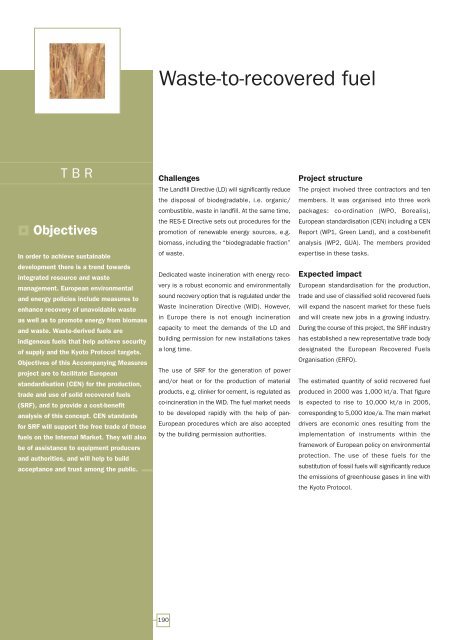European Bio-Energy Projects
European Bio-Energy Projects
European Bio-Energy Projects
Create successful ePaper yourself
Turn your PDF publications into a flip-book with our unique Google optimized e-Paper software.
TBR<br />
Objectives<br />
In order to achieve sustainable<br />
development there is a trend towards<br />
integrated resource and waste<br />
management. <strong>European</strong> environmental<br />
and energy policies include measures to<br />
enhance recovery of unavoidable waste<br />
as well as to promote energy from biomass<br />
and waste. Waste-derived fuels are<br />
indigenous fuels that help achieve security<br />
of supply and the Kyoto Protocol targets.<br />
Objectives of this Accompanying Measures<br />
project are to facilitate <strong>European</strong><br />
standardisation (CEN) for the production,<br />
trade and use of solid recovered fuels<br />
(SRF), and to provide a cost-benefit<br />
analysis of this concept. CEN standards<br />
for SRF will support the free trade of these<br />
fuels on the Internal Market. They will also<br />
be of assistance to equipment producers<br />
and authorities, and will help to build<br />
acceptance and trust among the public.<br />
Waste-to-recovered fuel<br />
Challenges<br />
The Landfill Directive (LD) will significantly reduce<br />
the disposal of biodegradable, i.e. organic/<br />
combustible, waste in landfill. At the same time,<br />
the RES-E Directive sets out procedures for the<br />
promotion of renewable energy sources, e.g.<br />
biomass, including the “biodegradable fraction”<br />
of waste.<br />
Dedicated waste incineration with energy recovery<br />
is a robust economic and environmentally<br />
sound recovery option that is regulated under the<br />
Waste Incineration Directive (WID). However,<br />
in Europe there is not enough incineration<br />
capacity to meet the demands of the LD and<br />
building permission for new installations takes<br />
a long time.<br />
The use of SRF for the generation of power<br />
and/or heat or for the production of material<br />
products, e.g. clinker for cement, is regulated as<br />
co-incineration in the WID. The fuel market needs<br />
to be developed rapidly with the help of pan-<br />
<strong>European</strong> procedures which are also accepted<br />
by the building permission authorities.<br />
190<br />
Project structure<br />
The project involved three contractors and ten<br />
members. It was organised into three work<br />
packages: co-ordination (WP0, Borealis),<br />
<strong>European</strong> standardisation (CEN) including a CEN<br />
Report (WP1, Green Land), and a cost-benefit<br />
analysis (WP2, GUA). The members provided<br />
expertise in these tasks.<br />
Expected impact<br />
<strong>European</strong> standardisation for the production,<br />
trade and use of classified solid recovered fuels<br />
will expand the nascent market for these fuels<br />
and will create new jobs in a growing industry.<br />
During the course of this project, the SRF industry<br />
has established a new representative trade body<br />
designated the <strong>European</strong> Recovered Fuels<br />
Organisation (ERFO).<br />
The estimated quantity of solid recovered fuel<br />
produced in 2000 was 1,000 kt/a. That figure<br />
is expected to rise to 10,000 kt/a in 2005,<br />
corresponding to 5,000 ktoe/a. The main market<br />
drivers are economic ones resulting from the<br />
implementation of instruments within the<br />
framework of <strong>European</strong> policy on environmental<br />
protection. The use of these fuels for the<br />
substitution of fossil fuels will significantly reduce<br />
the emissions of greenhouse gases in line with<br />
the Kyoto Protocol.

















